Jvc UX-G50-E, UX-G50-C Service Manual

SERVICE MANUAL
MICRO COMPONENT SYSTEM
UX-G50J,UX-G50C
|
SP-UXG50 |
CA-UXG50 |
SP-UXG50 |
|
|
|
|
|
|
|
|
|
|
|
Lead free solder used in the board (material : Sn-Ag-Cu, melting point : 219 Centigrade)
TABLE OF CONTENTS
1 PRECAUTION. . . . . . . . . . . . . . . . . . . . . . . . . . . . . . . . . . . . . . . . . . . . . . . . . . . . . . . . . . . . . . . . . . . . . . . . . 1-3 2 SPECIFIC SERVICE INSTRUCTIONS . . . . . . . . . . . . . . . . . . . . . . . . . . . . . . . . . . . . . . . . . . . . . . . . . . . . . . 1-6 3 DISASSEMBLY . . . . . . . . . . . . . . . . . . . . . . . . . . . . . . . . . . . . . . . . . . . . . . . . . . . . . . . . . . . . . . . . . . . . . . . 1-7 4 ADJUSTMENT . . . . . . . . . . . . . . . . . . . . . . . . . . . . . . . . . . . . . . . . . . . . . . . . . . . . . . . . . . . . . . . . . . . . . . . 1-14 5 TROUBLESHOOTING . . . . . . . . . . . . . . . . . . . . . . . . . . . . . . . . . . . . . . . . . . . . . . . . . . . . . . . . . . . . . . . . . 1-15
COPYRIGHT © 2006 Victor Company of Japan, Limited
No.MB509
2006/3
|
|
|
SPECIFICATION |
|
|
|
|
|
|
Amplifier section |
Output Power |
120 W per channel, min. RMS, driven into 6 Ω at 1 kHz with no more than 10% total har- |
||
|
|
|
monic distortion. |
|
|
Speakers Impedance |
6 Ω - 16 Ω |
|
|
|
|
|
||
|
Audio Input |
AUX |
Input sensitivity/Impedance: |
|
|
|
|
LEVEL1:150 mV/47 kΩ |
|
|
|
|
LEVEL2:500 mV/47 kΩ |
|
|
|
|
|
|
|
|
USB |
USB Ver. 1.1 |
|
|
|
|
|
|
Tuner section |
FM tuning range |
87.5 MHz - 108.0 MHz |
||
|
|
|
|
|
|
AM tuning range |
530 kHz - 1 710 kHz |
|
|
|
|
|
|
|
CD player section |
Dynamic range |
85 dB |
|
|
|
|
|
|
|
|
Signal-to-noise ratio |
85 dB |
|
|
|
|
|
|
|
|
Wow and flutter |
Immeasurable |
|
|
|
|
|
|
|
General |
Power requirement |
AC 120 V , 60 Hz |
|
|
|
|
|
|
|
|
Power consumption |
155 W (at operation) |
|
|
|
|
|
20 W (at standby) |
|
|
|
|
0.8 W (at on standby and Display off) |
|
|
|
|
|
|
|
Dimensions (approx.) |
175 mm × 246 mm × |
415 mm (6-15/16" × 9-11/16" × 16-3/8") (W/H/D) |
|
|
|
|
|
|
|
Mass (approx.) |
7.4 kg (16.4 lbs) |
|
|
|
|
|
|
|
Speakers |
Type |
2-way Bass reflex |
|
|
|
|
|
|
|
|
Speaker units |
Woofer |
12 cm (4") cone × 1 |
|
|
|
|
|
|
|
|
Tweeter |
4 cm (1-5/8") cone × |
1 |
|
|
|
|
|
|
Impedance |
6 Ω |
|
|
|
|
|
|
|
|
Dimensions (approx.) |
145 mm × 246 mm × |
212 mm (5-3/4" × 9-11/16" × 8-3/8") (W/H/D) |
|
|
|
|
|
|
|
Mass (approx.) |
2.2 kg (4.9 lbs) each |
|
|
|
|
|
|
|
Design and specification are subject to change without notice.
1-2 (No.MB509)
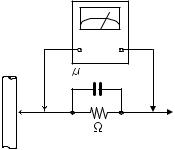
SECTION 1 PRECAUTION
1.1Safety Precautions
(1)This design of this product contains special hardware and many circuits and components specially for safety purposes. For continued protection, no changes should be made to the original design unless authorized in writing by the manufacturer. Replacement parts must be identical to those used in the original circuits. Services should be performed by qualified personnel only.
(2)Alterations of the design or circuitry of the product should not be made. Any design alterations of the product should not be made. Any design alterations or additions will void the manufacturers warranty and will further relieve the manufacture of responsibility for personal injury or property damage resulting therefrom.
(3)Many electrical and mechanical parts in the products have special safety-related characteristics. These characteristics are often not evident from visual inspection nor can the protection afforded by them necessarily be obtained by using replacement components rated for higher voltage, wattage, etc. Replacement parts which have these special safety characteristics are identified in the Parts List of Service Manual. Electrical components having such features are identified by shading on the schematics and by (  ) on the Parts List in the Service Manual. The use of a substitute replacement which does not have the same safety characteristics as the recommended replacement parts shown in the Parts List of Service Manual may create shock, fire, or other hazards.
) on the Parts List in the Service Manual. The use of a substitute replacement which does not have the same safety characteristics as the recommended replacement parts shown in the Parts List of Service Manual may create shock, fire, or other hazards.
(4)The leads in the products are routed and dressed with ties, clamps, tubings, barriers and the like to be separated from live parts, high temperature parts, moving parts and/or sharp edges for the prevention of electric shock and fire hazard. When service is required, the original lead routing and dress should be observed, and it should be confirmed that they have been returned to normal, after reassembling.
(5)Leakage shock hazard testing
After reassembling the product, always perform an isolation check on the exposed metal parts of the product (antenna terminals, knobs, metal cabinet, screw heads, headphone jack, control shafts, etc.) to be sure the product is safe to operate without danger of electrical shock.Do not use a line isolation transformer during this check.
•Plug the AC line cord directly into the AC outlet. Using a "Leakage Current Tester", measure the leakage current from each exposed metal parts of the cabinet, particularly any exposed metal part having a return path to the chassis, to a known good earth ground. Any leakage current must not exceed 0.5mA AC (r.m.s.).
•Alternate check method
Plug the AC line cord directly into the AC outlet. Use an
AC voltmeter having, 1,000Ω per volt or more sensitivity in the following manner. Connect a 1,500Ω 10W resistor paralleled by a 0.15µF AC-type capacitor between an exposed metal part and a known good earth ground.
Measure the AC voltage across the resistor with the AC
voltmeter.
Move the resistor connection to each exposed metal part, particularly any exposed metal part having a return path to the chassis, and measure the AC voltage across the resistor. Now, reverse the plug in the AC outlet and repeat each measurement. Voltage measured any must not exceed 0.75 V AC (r.m.s.). This corresponds to 0.5 mA AC (r.m.s.).
|
AC VOLTMETER |
|
(Having 1000 |
|
ohms/volts, |
|
or more sensitivity) |
0.15 F AC TYPE |
|
|
Place this |
|
probe on |
1500 10W |
each exposed |
metal part. |
|
Good earth ground
1.2Warning
(1)This equipment has been designed and manufactured to meet international safety standards.
(2)It is the legal responsibility of the repairer to ensure that these safety standards are maintained.
(3)Repairs must be made in accordance with the relevant safety standards.
(4)It is essential that safety critical components are replaced by approved parts.
(5)If mains voltage selector is provided, check setting for local voltage.
1.3Caution
Burrs formed during molding may be left over on some parts of the chassis.
Therefore, pay attention to such burrs in the case of preforming repair of this system.
1.4Critical parts for safety
In regard with component parts appearing on the silk-screen printed side (parts side) of the PWB diagrams, the parts that are printed over with black such as the resistor (  ), diode (
), diode (  ) and ICP (
) and ICP (  ) or identified by the "
) or identified by the "  " mark nearby are critical for safety. When replacing them, be sure to use the parts of the same type and rating as specified by the manufacturer.
" mark nearby are critical for safety. When replacing them, be sure to use the parts of the same type and rating as specified by the manufacturer.
(This regulation dose not Except the J and C version)
(No.MB509)1-3
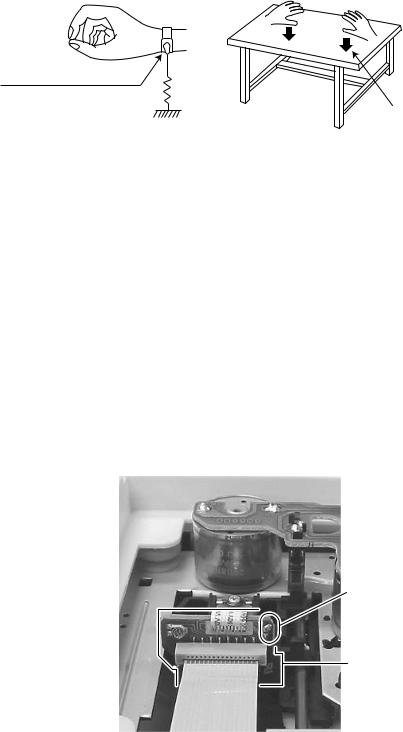
1.5Preventing static electricity
Electrostatic discharge (ESD), which occurs when static electricity stored in the body, fabric, etc. is discharged, can destroy the laser diode in the traverse unit (optical pickup). Take care to prevent this when performing repairs.
1.5.1Grounding to prevent damage by static electricity
Static electricity in the work area can destroy the optical pickup (laser diode) in devices such as laser products. Be careful to use proper grounding in the area where repairs are being performed.
(1)Ground the workbench
Ground the workbench by laying conductive material (such as a conductive sheet) or an iron plate over it before placing the traverse unit (optical pickup) on it.
(2)Ground yourself
Use an anti-static wrist strap to release any static electricity built up in your body.
(caption)
Anti-static wrist strap
1M
Conductive material (conductive sheet) or iron palate
(3)Handling the optical pickup
•In order to maintain quality during transport and before installation, both sides of the laser diode on the replacement optical pickup are shorted. After replacement, return the shorted parts to their original condition.
(Refer to the text.)
•Do not use a tester to check the condition of the laser diode in the optical pickup. The tester's internal power source can easily destroy the laser diode.
1.6Handling the traverse unit (optical pickup)
(1)Do not subject the traverse unit (optical pickup) to strong shocks, as it is a sensitive, complex unit.
(2)Cut off the shorted part of the flexible cable using nippers, etc. after replacing the optical pickup. For specific details, refer to the replacement procedure in the text. Remove the anti-static pin when replacing the traverse unit. Be careful not to take too long a time when attaching it to the connector.
(3)Handle the flexible cable carefully as it may break when subjected to strong force.
(4)I t is not possible to adjust the semi-fixed resistor that adjusts the laser power. Do not turn it.
1.7Attention when traverse unit is decomposed
*Please refer to "Disassembly method" in the text for the pickup unit.
•Apply solder to the short land sections before the flexible wire is disconnected from the connecto on the servo board. (If the flexible wire is disconnected without applying solder, the pickup may be destroyed by static electricity.)
•In the assembly, be sure to remove solder from the short land sections after connecting the flexible wire.
short rand
Pickup board
1-4 (No.MB509)

1.8Importance administering point on the safety
Full Fuse Replacement Marking |
Marquage Pour Le Remplacement |
|||||
|
|
|
Complet De Fusible |
|||
Graphic symbol mark |
Le symbole graphique (Ce symbole signifie |
|||||
(This symbol means fast blow type fuse.) |
||||||
fusible de type a fusion rapide.) |
||||||
|
|
|
||||
|
|
should be read as follows ; |
|
|
doit etre interprete comme suit ; |
|
|
|
|
|
|||
|
|
|
|
|||
|
|
|
^ |
|||
|
|
|
|
|
|
|
|
|
FUSE CAUTION |
PRECAUTIONS SUR LES FUSIBLES |
|||
|
|
|
|
|
|
|
FOR CONTINUED PROTECTION AGAINST RISK |
POUR UNE PROTECTION CONTINUE CONTRE |
|||||
OF FIRE, REPLACE ONLY WITH SAME TYPE |
DES RISQUES D'INCENDIE, REMPLACER |
|||||
AND RATING OF FUSES ; |
SEULEMENT PAR UN FUSIBLE DU MEME TYPE ; |
|||||
|
|
F901 : 3.15A 250V |
|
|
F901 : 3.15A 250V |
|
|
|
|
|
|
|
|
(No.MB509)1-5
SECTION 2
SPECIFIC SERVICE INSTRUCTIONS
This service manual does not describe SPECIFIC SERVICE INSTRUCTIONS.
1-6 (No.MB509)
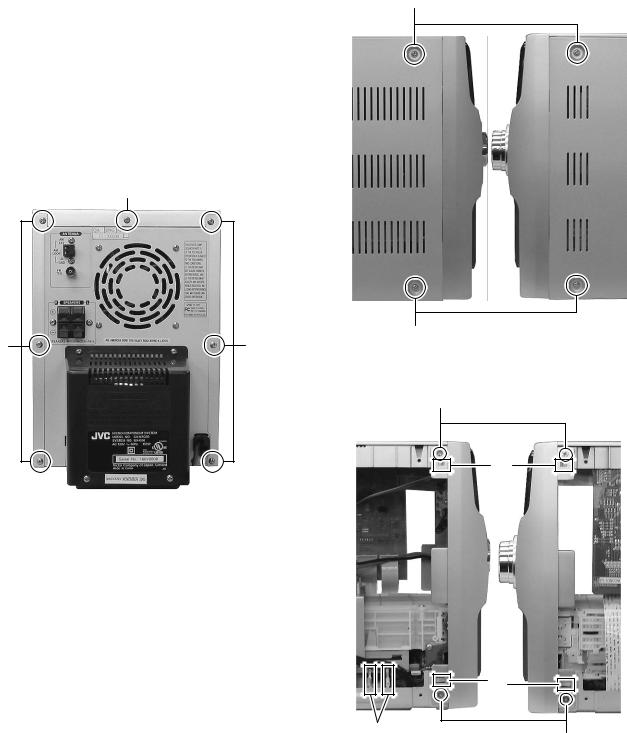
SECTION 3
DISASSEMBLY
3.1Main body
3.1.1Removing the metal plate (See Fig.1 and 2)
(1)Remove the six screws A attaching the metal plate from back side of main body. (See Fig.1)
(2)Remove the four screws B attaching the metal plate from both side of main body. (See Fig.2)
3.1.2 Removing the top cover (See Fig.1 and 3)
(1)Remove the one screw C attaching the top cover from back side of main body. (See Fig.1)
(2)Remove the two screws D attaching the top cover from both side of main body. (See Fig.3)
(3)Disengage hook a on both side of the front panel. (See Fig.3)
B
C
A |
A |
B |
|
Fig.2
D
a
Fig.1
c
Earth wire
P
Fig.3
(No.MB509)1-7

3.1.3 |
Removing the main board |
|
|
|
|
(See Fig.4) |
|
|
|
(1) |
Remove the two screws E attaching the main board. (See |
|
|
|
|
Fig.4) |
CN402 |
CN671 |
CN681 |
(2)Disconnect the card wires connected to connector CN402, CN411, CN412, CN661 and CN681 of main board.
(3)Disconnect the connector wire connected to connector CN671 of main board.
(4)Disconnect the board connector connected connector CN501 and CN601 between amp board and main board.
CN411 E |
CN601 |
CN501 E |
CN412 |
CN661 |
|
Fig.4
3.1.4Removing the power board (See Fig.5 and 6)
(1)Remove the two screws F attaching the power board. (See Fig.5)
(2)Disconnect the power cord connected connector CN901
and power transformer connector wire connected connec- |
CN901 |
tor CN902 of power board. (See Fig.5) |
|
(3) Disconnect the connector wire connected connector |
CN902 |
CN102 of amp board.(See Fig.6) |
|
F
Fig.5
CN181 CN102
Fig.6
1-8 (No.MB509)

3.1.5 Removing the rear plate (See Fig.7 and 8)
(1)Remove the four screws G attaching the trans cover. (See Fig.7)
(2)Remove the one screw H attaching the rear plate. (See Fig.7)
(3)Remove the two screws J attaching the speaker terminal. (See Fig.7)
(4)Disengage hook b on both side of main chassis. (See Fig.8)
(5)Disconnect the connector wire from fan connected connector CN105 of amp board.(See Fig.8)
3.1.6Removing the fan (See Fig.7)
(1) Remove the four screws K attaching the fan.
3.1.7 Removing the tuner pack (See Fig.7)
(1) Remove the two screws L attaching the tuner pack.
3.1.8 Removing the amp board (See Fig.6, 8 and 9)
(1)Disconnect the connector wire connected to connector CN181, CN204, CN205 and CN206 of the amp board. (See Fig.6 and 8)
(2)Remove the seven screws M attaching the amp board. (See Fig.9)
L
K
K
J
G
H
G
Fig.7
CN204 |
CN206 |
CN105 |
CN205 |
b |
|
|
|
|
b |
|
|
|
Fig.8
M
M
Fig.9
(No.MB509)1-9
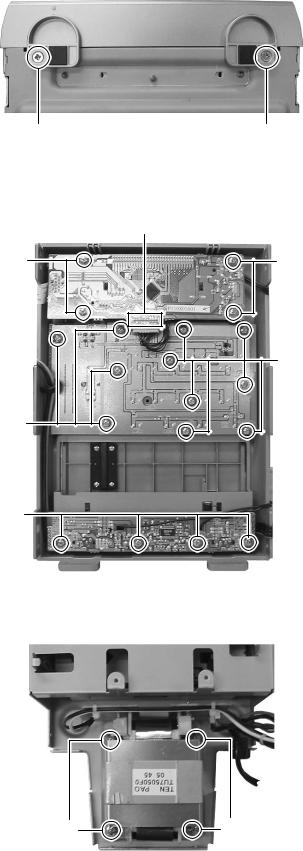
3.1.9Removing the front panel (See Fig.3 & 10)
(1)Remove the two screws N attaching the front panel assembly. (See Fig.10)
(2)Remove the two screws P attaching the front panel assembly. (See Fig.3)
(3)Disconnect the earth wires from main chassis. (See Fig.3)
(4)Disengage hook c on the both side of main chassis. (See Fig.3)
3.1.10Removing the front board (See Fig.11)
(1)Disconnect the connector wire connected connector CN301 of front board.
(2)Remove the four screws Q attaching the front board.
3.1.11Removing the key board (See Fig.11)
(1)Disconnect the volume knob.
(2)Remove the eleven screws R attaching the key board.
3.1.12Removing the USB board (See Fig.11)
(1) Remove the four screws S attaching the USB board.
N N
Fig.10
CN301
Q |
Q |
R |
R |
S
Fig.11
3.1.13 Removing the power transformer (See Fig.12)
(1)Remove the four screws T attaching the power transformer.
T T
Fig.12
1-10 (No.MB509)
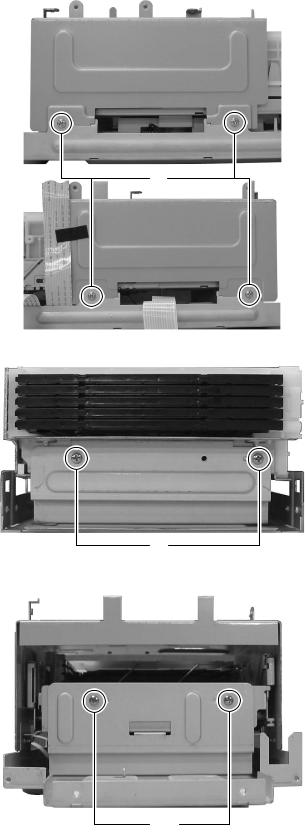
3.1.14 Removing the CD mecha cover (See Fig.13 to 15)
(1)Remove the four screws U attaching the CD mecha cover. (See Fig.13)
(2)Remove the two screws V attaching the CD mecha holder
F.(See Fig.14)
(3)Remove the two screws W attaching the CD mecha holder
R.(See Fig 15)
U
Fig.13
V
Fig.14
W
Fig.15
(No.MB509)1-11
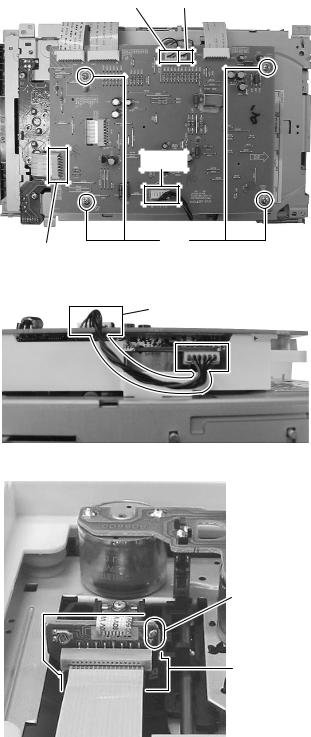
3.1.15Removing the CD board (See Fig.16 to 18)
(1) Disconnect the card wire from connector CN871 of CD |
|
board. (See Fig.16) |
CN873 CN872 |
(2)Disconnect the connector wire connected to connector CN872 and CN873 of CD board. (See Fig.16)
(3)Disconnect the connector wire from CN702 of CD board connected to motor board connector. (See Fig.17)
(4) Remove the four screws X attaching the CD board. (See Fig.16)
(5)Solder the short land section of the CD pickup. (See Fig.18)
Caution:
• |
Solder the short land section of the CD pickup before |
|
|
|
disconnecting the card wire from the connector on the |
CN702 |
|
|
CD pickup. If the card wire id disconnected without at- |
|
|
|
taching the solders, the pick up may be destroyed by |
|
|
|
static electricity. |
|
|
• |
When attaching the CD pickup, be sure to remove sol- |
|
|
|
ders from the short land section after connecting the |
X |
|
|
card wire to the connector on the CD pickup. |
||
|
CN871 |
||
(6) Disconnect the card wire from connector of CD pickup. |
|||
Fig.16 |
|||
(See Fig.18) |
|||
CN702
Fig.17
short rand
Pickup board
Fig.18
1-12 (No.MB509)
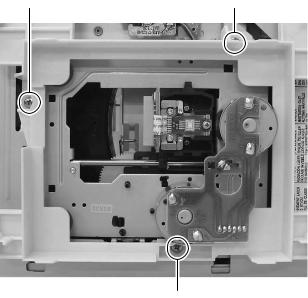
3.1.16 Removing the CD mechanism (See Fig.19)
(1) Remove the three screws Y attaching the CD mechanism.
Y Y
Y
Fig.19
(No.MB509)1-13
SECTION 4
ADJUSTMENT
This service manual does not describe ADJUSTMENT.
1-14 (No.MB509)
SECTION 5
TROUBLESHOOTING
This service manual does not describe TROUBLESHOOTING.
(No.MB509)1-15
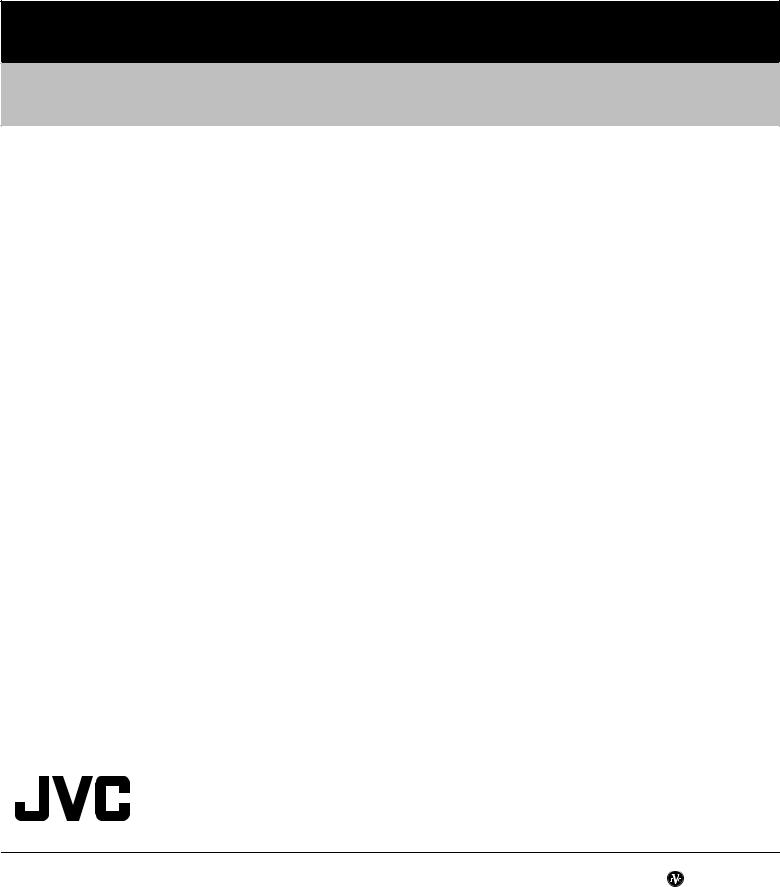
Victor Company of Japan, Limited
Audio/Video Systems Category 10-1,1chome,Ohwatari-machi,Maebashi-city,371-8543,Japan
(No.MB509)
Printed in Japan VPT
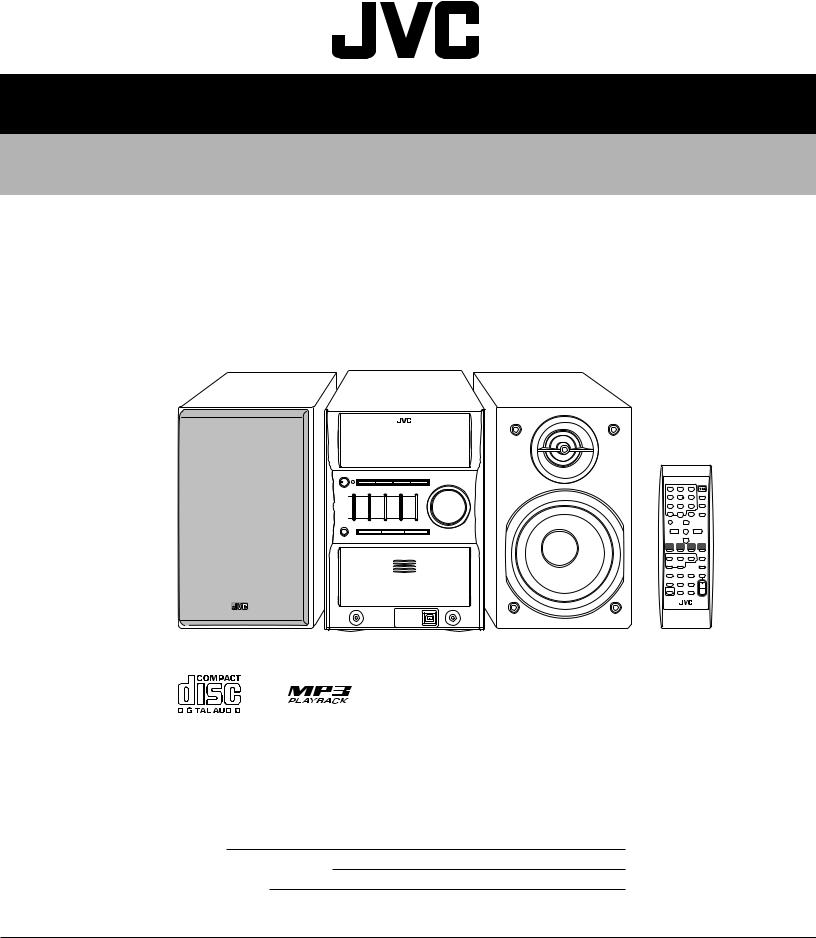
SCHEMATIC DIAGRAMS
MICRO COMPONENT SYSTEM
UX-G50J,UX-G50C
CD-ROM No.SML200603
|
SP-UXG50 |
CA-UXG50 |
SP-UXG50 |
|
|
|
|
|
|
|
|
|
|
|
Lead free solder used in the board (material : Sn-Ag-Cu, melting point : 219 Centigrade)
Contents
Block diagrams |
2-1 |
Standard schematic diagrams |
2-3 |
Printed circuit boards |
2-11 to 20 |
COPYRIGHT  2006 Victor Company of Japan, Limited.
2006 Victor Company of Japan, Limited.
No.MB509SCH
2006/3
